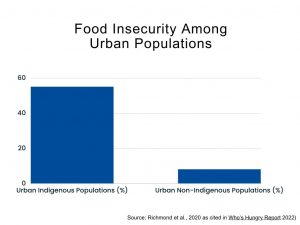Nutrition and Food
Current Nutrition Implications of Food Insecurity
In 2018, Our Health Counts produced a community-driven longitudinal study of Toronto’s urban Indigenous population using respondent-driven sampling to engage with 1200 adults and 600 children. This study found that 74% of Indigenous adults living in Toronto would prefer to eat more traditional foods than they do currently. Although 20% reported that they had enough food and of their preferred type, 55% reported that although they were able to access food, it was not their preferred type. In a year, 26% of families reported that they sometimes or often could not access an adequate amount of food. Due to their urban context, 87% of these families were unable to grow their own food.
The lack of access to traditional foods, either due to the living environment or the cost associated with purchasing traditional foods in the city, means that many urban Indigenous people experience food insecurity. To battle this issue, they may have to rely on food aid in the form of community support and food banks.
The Daily Bread Food Bank 2022 Who’s Hungry Report specifically profiles Indigenous food insecurity, noting this population accounts for about 3% of clients, while only making up about 1% of Toronto’s population (p. 22).
 A 2020 study confirms earlier reports of food insecurity of 55% for urban Indigenous populations, compared to 8% food insecurity experienced by non-Indigenous urban populations (Richmond et al., 2020 as cited in Who’s Hungry Report 2022). Clearly, the urban Indigenous population is greatly overrepresented in terms of food insecurity. This report suggests that these “disproportionate experiences of food insecurity are directly tied to the ongoing legacy of colonialism, anti-Indigenous racism, and systemic disinvestment in Indigenous communities. Damaging policies and practices, such as the residential school system and the 60s Scoop, have perpetuated cycles of poverty and intergenerational trauma among Indigenous communities” (Who’s Hungry Report 2022 p. 22).
A 2020 study confirms earlier reports of food insecurity of 55% for urban Indigenous populations, compared to 8% food insecurity experienced by non-Indigenous urban populations (Richmond et al., 2020 as cited in Who’s Hungry Report 2022). Clearly, the urban Indigenous population is greatly overrepresented in terms of food insecurity. This report suggests that these “disproportionate experiences of food insecurity are directly tied to the ongoing legacy of colonialism, anti-Indigenous racism, and systemic disinvestment in Indigenous communities. Damaging policies and practices, such as the residential school system and the 60s Scoop, have perpetuated cycles of poverty and intergenerational trauma among Indigenous communities” (Who’s Hungry Report 2022 p. 22).

